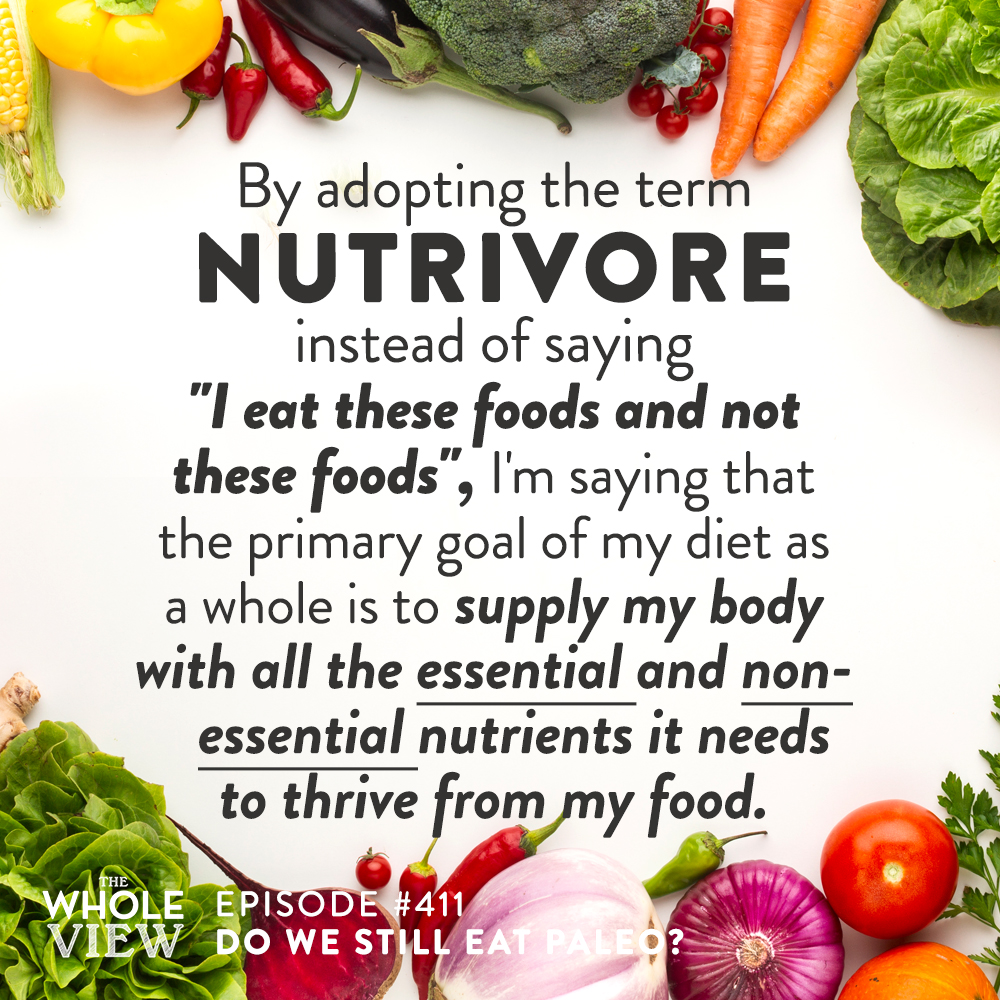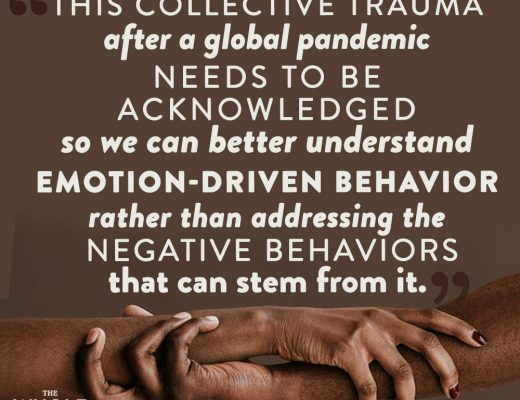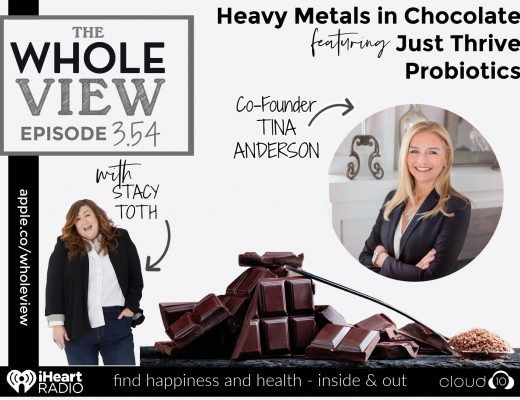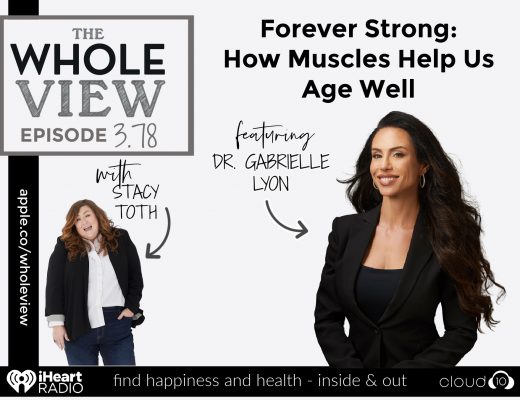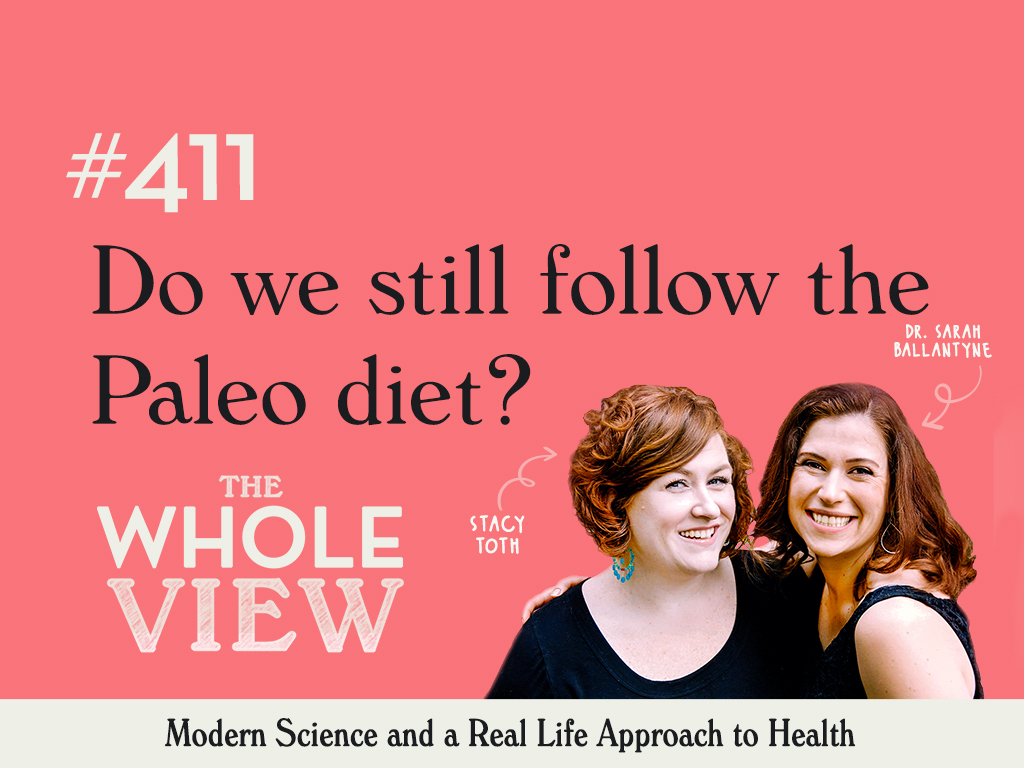
Welcome to episode 411 of The Whole View. On this week’s episode, Stacy and Sarah answer a listener’s question on how they now feel about the Paleo label. Do they still identify with the Paleo approach? What adjustments have they made to their principles after following the Paleo diet for almost a decade? All of this and more in episode 411!
If you enjoy the show, please review it on iTunes!
The Whole View, Episode 411: Do we still follow the Paleo diet?
Welcome back to the Whole View, episode 4-1-1. (0:27)
Does 411 still exist as a resource you can call?
This week, we have a really amazing question from Holly.
The topic is one that has been bouncing around in Sarah’s head for a while.
When she talks to someone about how she eats, it can be tricky to navigate what vocabulary to use.
So now seems like a really good time to dig into this, especially given the recent podcast name change.
Listener Question
Holly writes, “Hey ladies, I’m a long time listener of the podcast and I hope by telling you both how awesome you are that you will answer my question. (2:02)
Just kidding! But I know it can’t hurt and it’s true!
Really, thank you both for all the work you do to keep us in the know.
I have been finding the covid-19 shows so helpful and I feel like I get to rant with you both.
On to my question, Sarah I noticed your new book has non-Paleo and non-AIP foods in it and I know the podcast name has changed, so… do you both even still follow a Paleo diet?
I would love to know what your diets look like now.
Also, what do you both recommend now for all of us looking for general health guidelines, if Paleo is no longer the ‘thing’?
Thanks again for all you do!
P.S. Sorry Sarah if you cover this in the book, I admittedly have just done a quick scan, and I promise to read it soon.
Sarah’s New eBook
Sarah completely forgot to tell our podcast listeners that she just launched her Gut Microbiome eBook. (3:01)
The book that Holly is referring to is Sarah’s new Gut Health Guidebook.
Sarah has been working on a Gut Microbiome book for about six years now.
She started this book before writing Healing Kitchen.
Healing Kitchen was a book writing tangent, and then Paleo Principles was a second book writing tangent.
Since Paleo Principles came out, this book has been Sarah’s singular focus.
She was wrapping it up earlier this year and then when covid hit, it caused a delay in the publication process.
Sarah still doesn’t know when it will come out, but her guess is that at this point it will be sometime in 2021.
As soon as she found out that this was not going to be the late 2020 book she was pushing for, Sarah took the cohesive storyline of diet and lifestyle and package that up into an eBook.
The way that the Gut Microbiome book was coming together made it clear that it couldn’t be one book the way Paleo Principles is.
Sarah is taking the companion cookbook and is also going to create an eBook out of that content.
That will launch late this summer.
So the Gut Health Guidebook is now live and you can package it together with a preorder of the cookbook.
Sarah is offering a special discount for anybody who wants to do that.
To find the offer, see here.
From Stacy’s Point of View
Stacy and crew just got back from being in the wilderness for a week. (6:24)
She won’t call it camping because it is more glamping.
They prepped a lot of food before they left and cooked over the fire each night.
It is interesting for Stacy to think about this question in the context of having just been on that trip.
The different kinds of foods that they took this trip versus previous glamping trips
Things were very similar, with some exceptions.
As we talk about what they are each now doing and why, those points will weave in.
Years ago they did not take gluten-free graham crackers for example.
Stacy made Paleo chocolate chip cookies and then they made marshmallows and used those homemade creations for s’ mores.
She also wants to note for perspective that it has been over ten years since both Stacy and Sarah started their journey into what she would call a health awakening.
They started with this idea of Paleo, but that health awakening really started when Cole was born and Stacy was breastfeeding for the first time.
This is when Stacy realized that what she was eating was going directly into him.
That transitioned over many years until the birth of Wesley, and that was the point in which Stacy realized that her body was responding to certain foods in a way that was hurting her children when nursing.
Stacy has learned from her body what she tolerates vs. thrives on.
It is also interesting in this world of covid, how we need our bodies to be thriving, and to be as strong as possible.
Where you are is where you are, and there is no shame in where you have been or where you are going.
When we talk about diet we talk about how you choose to eat your food.
We are not talking about a fad diet, a way that you eat for short-term results.
This has always been a key concept on this show.
It has always been about a lifestyle.
If you focus on what feels best for you and listen to your body, you can find a way to live a balance in your life to not think about food as something as anything other than fuel.
Healthy Living
Stacy wants to refer everyone back to episode 358 on Intuitive Eating. (11:16)
This show is very representative of our thoughts on anti-diet and intuitive eating.
On this episode, we share how you can incorporate this into a way of healthy living.
There is a response that your body has to certain foods, and to ignore that is not beneficial to your long-term health.
But how can you incorporate those foods without it being a diet that you punish yourself for?
This turns food into a reward, which isn’t good either.
If you find yourself in a place where food has that kind of control or thought pattern, please go back and listen to that episode.
It will really tell the full picture of what we are doing to fuel and nourish ourselves.
We try to optimize thriving, while still representing the emotional importance of some of that stuff.
From Sarah’s Point of View
Sarah loves how Stacy framed the way that her healthy awakening journey began because Sarah’s started with Adele. (12:33)
In her first pregnancy, she has gestational diabetes and she managed her blood sugar really well with careful measuring.
When Adele was one she realized that she was getting that same sickish feeling every time she ate.
Sarah still had her blood sugar testing supplies and one day after lunch decided to test her levels.
Her levels were 200, which is the cusp between pre-diabetes and type-2 diabetes.
She does not recommend this at all, but Sarah never told her doctor.
Sarah felt so much guilt around this reality as she was intimately aware of the consequences of diabetes.
So that day was the day that she changed her diet, and she went to the thing she knew.
Sarah went low-carb, and in many ways, the last ten years has been a road of recovering from that stretch of low-carb.
She was able to lose weight and normalize her blood sugar levels and blood pressure.
She had markers showing her that she was healthy, but her autoimmune diseases were getting worse.
It was a tradeoff.
When Sarah’s youngest daughter was closing in on two, it was actually the autoimmune flairs that brought her to Paleo.
Sarah’s immediate was response was that Paleo was crazy, but as she dug into it the science made sense.
Once Sarah got into it, she went cold turkey with it on August 31, 2011, which helped a lot of things.
However, it didn’t help everything so for her New Year’s resolution that year she started the autoimmune protocol.
At that time AIP was very poorly defined.
So Sarah defined and established what AIP was and is now, at the same time she was doing it.
Sarah was very influenced by Dr. Terry Wahls TEDx presentation.
More on Sarah’s Journey
So she used her knowledge base to understand how foods interact with the human body, throughout this entire experience. (18:36)
And she has never stopped continuing to learn.
As Sarah has continued to learn, she has continued to tinker with her diet.
Over the years this has turned into something that she doesn’t know if Paleo is the correct label to describe how she eats now.
The term Paleo, as is typically defined, is still defined as what you don’t eat.
Sarah doesn’t believe that what you eliminate makes a diet healthy or not.
It is actually the foods that you eat that is what determines whether or not that diet is healthy.
And it is the nutrient density that serves as the primary criteria as to whether or not a diet supports health.
Eliminations are things that you add on top of that to address specific health challenges or goals.
Sarah’s diet has really expanded over that time.
This started in October of 2012 with methodical reintroductions after having followed the AIP for about 10-months.
A lot of those reintroductions were successful.
When she started the AIP Lecture Series in 2019 she realized that she was scared to reintroduce beyond what she had already done.
Sarah was so comfortable with where she is at that she didn’t want to reintroduce anything further and run into possible setbacks.
However, she realized that she really needed to change her mindset around that.
When you can expand your diet to allow for nutrient expansion, that is making strides towards improved health.
This microbiome research has solidified Sarah’s feelings towards a lot of the foods that the Paleo diet has been criticized for eliminating.
Legumes and rice are two examples that Sarah highlighted.
Where Paleo Fell Short
One of the things that Paleo has failed in terms of serving its community, is the way it has lumped foods together. (23:19)
The framework of the diet says no grains, no dairy, no legumes, and no processed foods.
Sarah feels that it is unfair to lump all of those foods together.
There are some terrible grains, and there are actually some grains with science to back their different benefits.
This is true for legumes as well.
When you look at the gut microbiome you can see very clearly which grains and legumes benefit the gut microbiome and which don’t.
So as Sarah was pulling together this information, she started methodically challenging legumes, dairy, tomatoes, and switched from white to brown rice.
What worked has become very moderate additions to her diet.
Sarah’s diet is still mostly vegetables, fruit, and a moderate serving of protein.
Introducing these other foods requires a more nuanced approach.
It requires being able to not lump everything together and select what to eat carefully.
If we take this nutrient-density approach, then we are eating what we need to thrive, and it changes how we tolerate some foods that might have antinutrients, but ultimately have a lot of valuable nutrition to provide the body.
Stacy thinks that there are a lot of things that we have talked about on this show that are all over the place if you are trying to track when and how Stacy and Sarah’s journies unfolded.
We know this sounds very complicated.
However, doing simple things like meal planning help to make sure that you have certain foods on your meal plan several times a week will simplify the process.
For Stacy, it can be something as simple as making homemade tuna salad.
Stacy’s Journey
Stacy and Sarah have had a similar approach. (29:57)
However, Stacy will admit that her approach is a lot less focused on as many nutrients as Sarah is committed to.
If Sarah’s is more Paleo 80/20, Stacy thinks her approach is more 75/25.
However, it is also important to understand that her goal is no longer weight loss.
She lost 134 pounds at the peak of her weight loss, but she only got to that number of the scale one day and she did it through disordered eating.
Stacy justified the disordered eating with intermittent fasting.
As a result of her habits, she had digestive distress which caused nutrient deficiency, and she had a thyroid nodule and a huge flair.
Sarah and Stacy, along with a medical professional, had to work to help Stacy restore her health during that period.
It got really bad healthwise and she needed to recover.
Not just gut health had to recover, Stacy’s body was in a bad place.
In 2015, Stacy asked the question, is your Paleo challenge justifying disordered eating?
This was controversial because at the time many were doing Paleo challenges every other month as a “normal” part of their diet.
Stacy pointed out that this is not being Paleo, and eating to incorporate a nutrient-dense, anti-inflammatory lifestyle.
This is using Paleo as a yo-yo diet.
The more Stacy became aware of what was happening to her and many others in the community, it was where Stacy and Sarah started talking about metrics of health.
There was also a lot of fatphobia in the community.
More on Stacy’s Journey
From Stacy’s perspective and awakening in all of this is still very health-focused. (32:19)
Stacy wants health, wellness, and longevity for her family.
Her original goal with starting Paleo was that she had such low energy and wanting to play with her kids.
Thinking about that original goal and where she is at today, Stacy feels that food enabled her to have the energy she needed to get more active.
She is worlds apart from where she was in terms of her energy levels and wellness in general.
Stacy did put on weight as she came out of that low-carb, Paleo period.
That was her starved, it was not a real weight.
Stacy ended up rebounding and reaching a really good place until she injured her back, which then she couldn’t move for a year.
Stacy put on weight from that period of time, but she has maintained a significant amount of that weight that she originally lost.
However, Stacy really doesn’t weigh herself due to her history with how she equates her worth to that number on the scale.
Body positivity and self-love have become very important to Stacy as she optimizes her health.
Stacy looks at food and asks herself, “is what I am consuming going to give me wellness and longevity?”
And sometimes that is the motivating factor she needs to not get ice cream or whatever it is.
This comes from a much different place, one without deprivation and punishment and those kinds of things that Stacy did for so long.
And it is not linear.
For Stacy, she didn’t flip a switch and was fixed.
These are habits that she has to consistently work on and quarantine has not been easy.
Nutrivore
This is where Stacy has really changed her mindset, as she first and foremost thinks of herself as a nutrivore, someone who prioritizes nutrient density. (35:49)
Stacy recognizes that they can’t have a diet of only white rice, but if they are sick and that is the only thing they are able to keep down, how can they optimize it?
They can put in grass-fed ghee, cook the rice in bone broth, put kelp on top, and then for their next meal find something else like sweet potatoes to fill the carb cravings.
Stacy does focus on adding nutrient density and vegetables to what she describes as a gluten-free, corn-free, legume-free, and night-shade free diet.
She would love to be able to eat those foods, but they don’t agree with her body.
Stacy is not dairy-free in the same way that Sarah is.
She can tolerate more dairy, but not every day.
The dairy that Stacy tolerates is fat only forms.
Stacy feels that there is a big difference in the thought process from where they were, to where they are now.
Sarah’s Implementation of a Nutrivore Diet
Sarah has something very similar. (38:16)
Prior to covid, when Sarah ate in a restaurant she would say she is gluten-free, dairy-free, and soy-free.
These are things she knows she can’t do.
The term that Sarah most resonates with now is nutrivore.
This best describes Sarah’s approach because she looks at food as providing her body with the resources it needs to do all the things it wants to do.
And those resources are nutrients.
By adopting the term nutrivore, instead of saying “I eat these foods and not these foods”, I’m saying that the primary goal of my diet as a whole is to supply my body with all the essential and non-essential nutrients it needs to thrive from my food.
That is the goal.
You can basically fit junky calories into your diet if the bulk of your diet is made up of super nutrient-dense foods.
Because those junky calories at that point are not taking away from meeting that goal of getting all of the nutrients that your body needs.
This helps us get away from food labels of good vs. bad, and gets into what is the quality of my diet?
Did I meet my nutritional needs today?
And did I meet those needs today with some energy deficit?
Sarah likes that this moves us away from stigmatizing foods.
However, it still recognizes foods that aren’t good for anybody.
Sarah doesn’t believe that everyone needs to be strictly gluten-free.
As we get away from demonizing foods, we can get back to the thing that is most important.
Meeting the body’s nutritional needs is a top priority.
From there you can layer eliminations on top of that, or add additional nutritional focus on top of that to meet specific health challenges and goals.
For example, Sarah thinks of AIP as a sub diet of a nutrivore approach.
There is now emerging science showing that the gut microbiome really needs a minimal amount of carbohydrate.
This amount is probably at least 150 grams a day, if not 200 grams a day.
How to Describe It
If Sarah were to describe her diet to someone who was serving her food, she would describe it as gluten-free, dairy-free, and soy-free. (43:44)
If she was talking to her neighbor who wanted to make some dietary changes she would probably use the word nutrivore.
Sarah would then talk about the importance of eating a lot of vegetables, higher-quality meat, more seafood, eating fruit, eating a serving of mushrooms a day, and a palm-full of nuts a day.
She would also talk about snout-to-tail eating.
Also why soaking legumes is still a best practice.
The focus would be on eating more nutrient-dense foods and allowing them to displace the foods that aren’t doing us any favors.
Rather than eliminating foods that are put into this ‘no’ category.
Stacy thinks this perspective is helpful.
It is helpful to be reminded of what our ultimate goal is.
We are then able to ask, ok, how do we get there in a sustainable way.
If you are overly restrictive and you can’t stick with that, it isn’t good either.
How can you optimize without boomeranging to the other side?
Customization
Stacy wants to point out a few more things that are unique to her since she doesn’t have a gallbladder. (46:05)
She has to pay particular attention to fats.
Matt and Stacy have added more olive oil and avocado oil, and use less lard.
They also eat gluten-free treats.
Stacy doesn’t do oats, and they don’t do legumes in their family.
They do have brown rice pasta about once a week.
If Stacy does have a meal of rice or pasta, she does try to ensure that she has a veggie-rich meal on that day to make up for the overall vegetables and nutrients that she is trying to achieve every day.
She also tries to move her body.
It is about how she feels, and she has to listen to her body.
Sarah doesn’t feel bad about cooking brown rice pasta at all.
Especially after going through the gut microbiome researching and learning about how good rice is for the gut microbiome.
It is not a base food because it doesn’t have a ton of nutrition, but in the context of a meal that incorporates other nutrient-dense options, it becomes a good contribution.
Stacy mentioned this blog post on casserole prep.
She also takes supplements of daily collagen but doesn’t drink broth as often as she use to.
Stacy also takes liver pills, vitamin D, and magnesium.
She is also adding mushrooms with more intention these days.
Stir-fries are a favorite these days, as Stacy finds it easy to add nutrients to these dishes.
Stacy has added things in, but it hasn’t been as thoughtful as Sarah’s process.
However, she is very aware of what they are adding and what they are or aren’t doing.
Stacy strives to be mindful of balance because social and emotional wellbeing in terms of sustainability and disordered eating has been so impactful to Stacy.
She has had to really learn to listen to her body and really find a balance on how she feels in terms of digestion and energy, more than anything else for it to work long-term.
It is important to Stacy to not feel bad or to go off the rails.
This can be hard if you come from a place of dysmorphia or eating disorders or any kind of stuff like that.
For Stacy, she has worked on that stuff and gone to therapy and become self-aware.
If you are struggling with this stuff, you can’t just solve it in a vacuum.
When there is emotions around your food, you do have to address the emotion or else you will never solve the problem.
Closing Thoughts
One of the things that have allowed Sarah to embrace the term nutrivore is to develop a healthier relationship with food. (1:01:03)
Just like when we first adopted Paleo, nine to ten years ago, that was always going to be a lifestyle.
It has evolved, and her diet has expanded.
While Sarah thinks of it as nutrivore, you could also call it AIP maintenance phase, or Paleo plus, or 80/20.
There are other labels that we can use, but it is still a lifestyle.
It is about lifelong health and hopefully improving her longevity.
This still includes getting enough sleep, managing stress, living an active lifestyle, and nature time.
These are all still pieces of the health puzzle for Sarah.
But what she has been able to do by shedding the dogmatic rules that have been associated with the Paleo diet for so long is to develop a healthier relationship with food.
One of the side effects this has had is that portion control is much easier, which has always been a real struggle for Sarah.
This healthier relationship with food has allowed Sarah to regular her cravings and appetite.
Getting beyond Paleo has allowed Sarah to fix some of the food relationship problems that she was still having on the Paleo diet.
Stacy and Sarah have been talking about doing some changes on the show for a long time, and you are seeing some of them with the name change of the show.
They are planning to let go of their G-rating soon so that they can relax a bit on things.
Stacy and Sarah’s true unfiltered thoughts on things will be coming through in the next few weeks.
That is it for this week’s episode.
Thank you for listening, and we will be back next week! (1:07:20)
